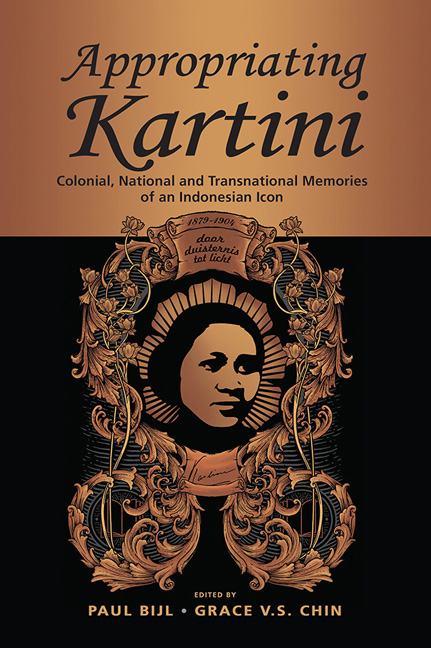Book contents
- Frontmatter
- Contents
- Acknowledgments
- The Contributors
- 1 Introduction
- 2 Crafting Reform: Kartini and the Imperial Imagination, 1898–1911
- 3 Hierarchies of Humanity: Kartini in America and at UNESCO
- 4 Ambivalent Narration: Kartini’s Silence and the Other Woman
- 5 Unpacking a National Heroine: Two Kartinis and Their People 103
- 6 Call me Kartini? Kartini as a Floating Signifier in Indonesian History
- 7 Kartini and the Politics of European Multiculturalism
- 8 Afterword
- Index
6 - Call me Kartini? Kartini as a Floating Signifier in Indonesian History
Published online by Cambridge University Press: 02 April 2020
- Frontmatter
- Contents
- Acknowledgments
- The Contributors
- 1 Introduction
- 2 Crafting Reform: Kartini and the Imperial Imagination, 1898–1911
- 3 Hierarchies of Humanity: Kartini in America and at UNESCO
- 4 Ambivalent Narration: Kartini’s Silence and the Other Woman
- 5 Unpacking a National Heroine: Two Kartinis and Their People 103
- 6 Call me Kartini? Kartini as a Floating Signifier in Indonesian History
- 7 Kartini and the Politics of European Multiculturalism
- 8 Afterword
- Index
Summary
Introduction
Every year on 21 April, Kartini's birthday, Indonesia celebrates Hari Kartini (Kartini Day). A day of civic celebration, it is marked by ceremonies, especially in schools and government institutions; and by reflections in the mass media on the state of women's social participation, challenges and achievements. This annual event has come to be focused, in often contradictory ways, on the “place of women” in modern Indonesia. Kartini's literary writings have been “mined” to give multiple and even contradictory characterizations of her voice, and hence of her historical significance.
This Chapter tracks the evolution of the trope of “Kartini” as a national heroine. “Kartini” has become a concept that organizes the idea of “Indonesian women”, a signifier that is deployed politically, and culturally, as part of a system of meaning-making. Her life and ideas have emerged as a “floating signifier” in Indonesian political, social and cultural discourse. While the term may appear to have a fixed referent in a historical personage, “Kartini” is given different meanings in different times, and is neither static nor solid. It shifts and slides in the process of making meanings that express contesting political discourses. In particular, this Chapter addresses the varying, shifting “Kartinis” associated with official and dissident gender politics in post-independence Indonesia in the following contexts: Sukarno's Old Order, Suharto's New Order, the contested space of Reformasi, and the contemporary post-Reformasi multimedia environment of jaman now (the “now” generation). In this Chapter, I use “Kartini” to refer to instances of the floating signifier, while references to the historical Kartini are unmarked (i.e. Kartini).
Knowing Different “Kartinis”
Kartini has become a historical figure because of the publication of her letters, written over four years of her short life (see Introduction to this volume). Hence we know her mainly as a literary figure.
Her bupati father allowed her to attend the local Dutch-language primary school, and this enabled her to interact in a colonial social milieu where she developed friendships with Dutch people, including many who visited her home. She corresponded with several of them, and we know her through her letters, in particular those she wrote to Rosa Abendanon-Mandri, the wife of a colonial official, and her earlier correspondence with Stella Zeehandelaar, a Dutch feminist whom she’d never met.
- Type
- Chapter
- Information
- Appropriating KartiniColonial, National and Transnational Memories of an Indonesian Icon, pp. 131 - 156Publisher: ISEAS–Yusof Ishak InstitutePrint publication year: 2020

